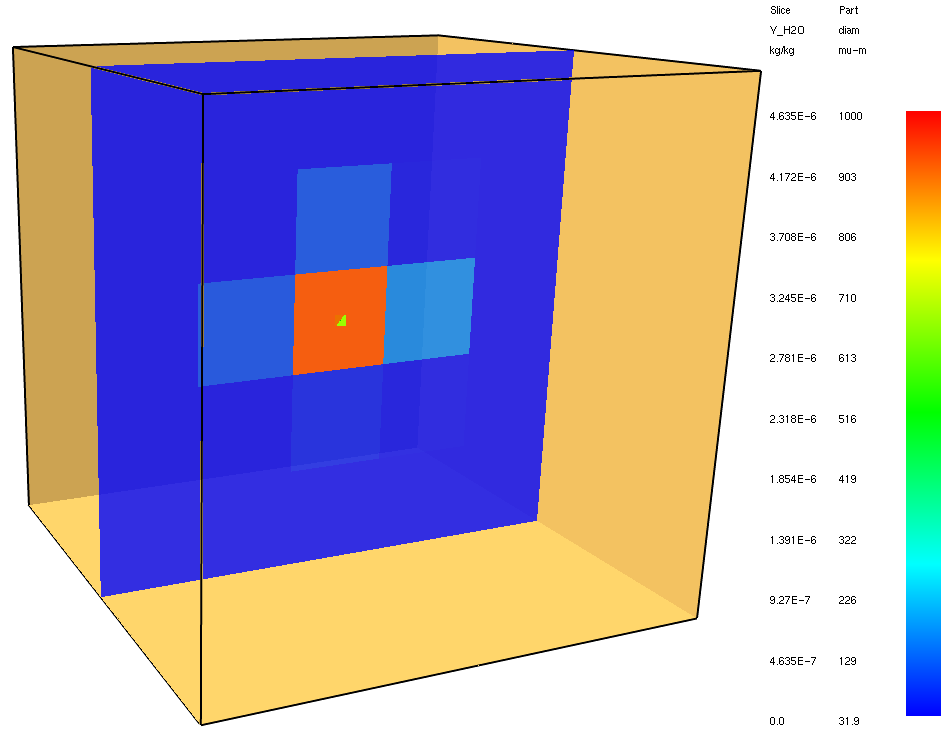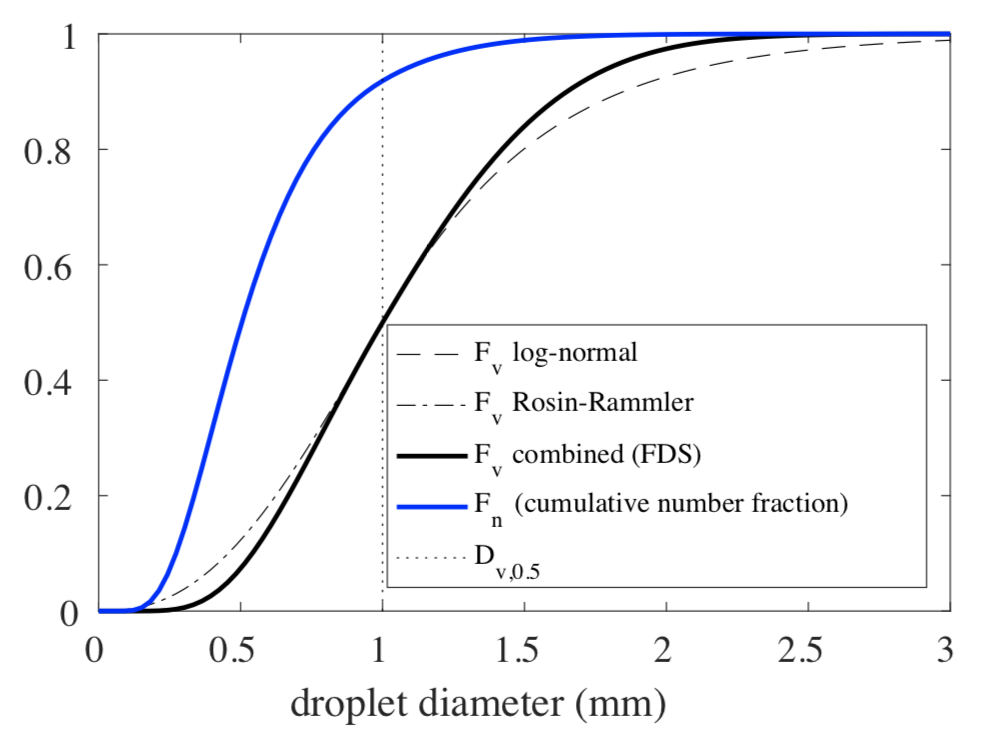import fdsreader
import matplotlib.pyplot as plt
import numpy as np
# Set the matplotlib output to svg
from IPython.display import set_matplotlib_formats
set_matplotlib_formats('svg')
import os
# check for set environment variable JB_NOSHOW
show = True
if 'JB_NOSHOW' in os.environ:
show = False
7.1. Modelling#
General Idea#
Particles are used to represent
object smaller than the grid spacing
liquid and solid fuel particles
water droplets
massless tracer particles
As it is not possible to modell each individual particle, the particle ensemble is modelled as Lagrangian particles. This concept is based on the following assumptions
definition of representative particles,
each of the Lagrangian particles represents a set of physical particles with its properties, like the diameter spectrum, and
interaction of the particles with the fluid and other particles.
Transport Equations#
As a particle moves in a fluid, it transfers momentum to a fluid element
with
\(\mf V_{cell}, \rho, \vec{v}\): gas phase properties
\(\mf \vec{v}_p, m_p, A_{p,c}\): particle properties
\(\mf C_d\): drag coefficient
The total particle acceleration for a single particle \(\mf p\) is given by
and the particle position can be computed using the following equation
The movement and momentum transfer of the particles depend on the drag coefficient \(\mf C_d\), which can be computed as
Where the Reynolds number is given as
with
\(\mf \rho, \vec{v}, \mu(T)\): gas properties
\(\mf \vec{v}_p, r_p\): particle properties
This formula is for spherical particles, formulas for other shapes are available.
Example – Single Particle Trajectory#
An input file for FDS, where a single particle is injected with a given initial position and velocity, is shown in the following listing.
# Adopted from the FDS example repository
&HEAD CHID='out_single_particle', TITLE='Particle Trajectory' /
&MESH IJK=30,30,10, XB=-1.,29.,-1.,29.,0.,10. /
&TIME T_END=2.5, DT=0.1/
&SPEC ID='WATER VAPOR' /
&PART ID='DROPLET',
SPEC_ID='WATER VAPOR',
DIAMETER=1000,
SAMPLING_FACTOR=1,
MONODISPERSE=.TRUE. /
&INIT ID='INJECTOR',
XYZ=0.0,0.0,0.5,
UVW=10.,10.,10.,
PART_ID='DROPLET',
N_PARTICLES=1 /
&TAIL /
In the above example, a particle property (PART) is defined. It states, that the particle species is a water (WATER VAPOR) droplet with a diameter of \(\mf 1~mm\) (DIAMETER). In general, a diameter spectrum is definied, thus the diameter statement represents just a property of the distribution function, as shown later. Here, the option MONODISPERSE=.TRUE. is used to generate particle with a single diameter. The SAMPLING_FACTOR controls how many particles should be written to the output file, where its value states that every nth particle is written out. Here, every particle is recorded.
The particle is injected using the INIT statement. It defines the positon (XYZ), the velocity (UVW) and the number of injected particles (N_PARTICLES) of the particle property (PART_ID).
Task 1#
Run a simulation with the above input file and visualise it with Smokeview.
Task 2#
Plot the evelation of the particle as a function of time and as a function of the projected (x-y-plane) distance to the initial position, like in Fig. 7.1 and Fig. 7.2.
sim = fdsreader.Simulation('../../../../data/particles/single_particle/rundir/')
part_pos = sim.particles[0].positions
part_time = sim.particles[0].times
px = []
py = []
pz = []
pt = []
for i in range(len(part_pos)):
cpos = part_pos[i]
if len(cpos) > 0:
px.append(cpos[0,0])
py.append(cpos[0,1])
pz.append(cpos[0,2])
pt.append(part_time[i])
px = np.array(px)
py = np.array(py)
pz = np.array(pz)
pt = np.array(pt)
Fig. 7.1 Position of the partile as a function of time.#
Fig. 7.2 Trajectory of the particle.#
Task 3#
Instead of a single particle, adopt the input file to insert three particles. They should differ in diameter, e.g. \(\mf 10~mm\), \(\mf 1~mm\), and \(\mf 100~\mu m\), as well as their injection time. Chose an injection time with a separation of one second.
Plot their trajectories.
Fig. 7.3 Trajectory of three particles with different diameters.#
Example – Heat and Mass Transfer#
Particles are in thermal interaction with the fluid and vice versa. Liquid particles can evaporate gas if the according conditions, temperature and partial pressure, are met.
The following example illustrates the evaporation of a water droplet in a warm surrounding.
&HEAD CHID='out_particle_evaporation', TITLE='Evaporation of a liquid particle' /
&MESH IJK=5,5,5, XB=-1, 1, -1, 1, 0, 2 /
&TIME T_END=60, DT=0.05/
&SPEC ID='WATER VAPOR' /
&MISC TMPA=200., HUMIDITY=0 /
&PART ID='DROPLET',
SPEC_ID='WATER VAPOR',
STATIC=.TRUE.,
KILL_DIAMETER=1,
DIAMETER=1000,
MONODISPERSE=.TRUE.,
INITIAL_TEMPERATURE=0,
QUANTITIES(1:2)='PARTICLE DIAMETER','PARTICLE TEMPERATURE',
SAMPLING_FACTOR=1
/
&INIT ID='INIT',
XYZ=0.0,0.0,1.0,
UVW=0.0,0.0,0.0,
PART_ID='DROPLET',
N_PARTICLES=1
/
&TAIL /
Task 1#
Run the input file and observe the reduction of the particle diameter. Particles can be colored in Smokeview. The quantity used for coloring can be selected under Show/Hide – Particles.
Task 2#
Add a slice file for the water vapour density in the gas phase.

Fig. 7.4 Slice with the species concentration.#
Task 3#
Add the needed output data to plot the particle diameter and temperatur as a function of time.
Fig. 7.5 Particle diameter as a function of time.#
Fig. 7.6 Particle temperature as a function of time.#
Task 4#
Extend the input file by a device, which computes the volume integral of the water vapour density and compare the mass of the particle and the mass of water vapour in the domain as a function of time.
Fig. 7.7 Mass exchange between the evaporating particle and the gas phase.#
Particle-Particle Interaction#
In cases where the particle density is high, particles start to interact with each other. Either directly via collisions or indirectly via a fluid interaction. The particle-fluid-particle interaction can lead to the reduction of the drag coefficient. This effect starts at the distance of the particles drops below 10 particle diameters of a volume fraction of about \(\mf \alpha = 0.01\).
The fraction of the reduced drag coefficient of the tailing particle w.r.t. the isolated one can be expressed with the ratio of the hydrodynamic forces.
where the index 0 indicated the single isolated particle. The forces are defined using the wake velocity \(\mf W\)
with \(\mf L\) as the distance between the particles, \(\mf D\) the particle diameter and \(\mf L/D\) the separation distance.
The resulting force ratio is a complex function of \(\mf W, Re, L/D\). Using the local volume fraction, the separation distance can be estimated as
where \(\mf \tilde{D}\) is the local average particle diameter. This approach to estimate the reduction has limitations and significantly under-estimates the numbers as at short distances the wake field is not well developed.
Droplet Sizes and Weighting#
In general, the size of the particles depends on the creation process. In case of sprinkler, this may be impacted by the the nozzle diameter and geometry as well as the operating pressure. The sprinkler pressure determines also the mass flow \(\mf \dot{m}_p\) and the particle velocity \(\mf \vec{v}_p\).
The diameters are rarely of same size, but are a spectrum, which can be described with a distribution function. FDS uses a combination of a log-normal and a Rosin-Rammler distribution function. The first one is used for small particles sizes, up to the median of the distribution function \(\mf D_{v,0.5}\), and the second for larger particles. The cumulative size distribution is therefor
with the parameters \(\mf \gamma = 2.4\) and \(\mf \sigma=0.48\).

Fig. 7.8 Cumulative distribution function of the particle diameters. Source: [MHF+20d].#
A Lagrangian particle represents a set of physical particles. The weighting factor \(\mf C\) indicates the scaling of the particles contribution to mass, momentum and heat transfer. The procedure used in FDS to compute the weighting factor is as follows:
define mass flow \(\mf \dot{m}_p\), insertion time \(\mf \delta t\) and the number of particles \(\mf N\)
divide diameter range in bins, default is 7
randomly distribute \(\mf N\) on the bins
for each particle pick a random diameter from the corresponding bin
the particle’s weighting factor \(\mf C_i\) corresponds to the number of particles inside the bin
total weighting factor \(\mf C\) is given by the mass balance

